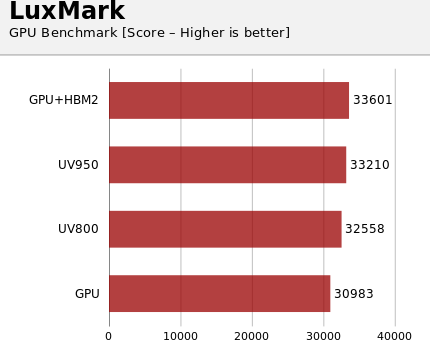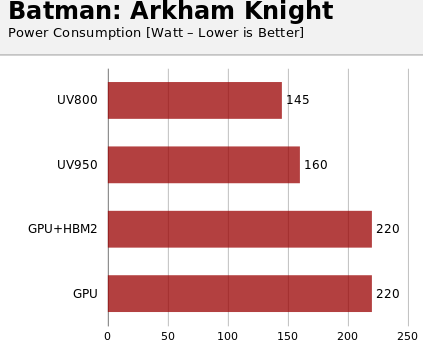Article by Federico Barutto
The way Vega GPUs work is very particular, thanks also to a bad description of a fundamental WattMan setting. “HBM2 voltage” isn’t actually the voltage of the HBM2 chips (fixed at 1.2V on RX Vega 56s, and 1.35V on RX Vega 64s and Frontier Edition), but is more like a GPU voltage/frequency threshold.
By lowering this “HBM2 voltage” (Vbase, shortly) to 850mV you have the opportunity to undervolt nearly as much as you want the GPU, heavily reducing power consumption without losing too much performance if the card is water cooled, or actually enhancing them if the card is air-cooled.
If the power limit (PL) is kept at 0%, every GPU voltage (Vcore) over 1130mV is useless, since the card reaches its 220W (=~295W to the PCIe connectors) PL. On a watercooled card, GPU frequency is around 1580MHz.
By lowering Vcore to 950mV, GPU frequency lowers a bit to ~1530-1550MHz, but power consumption lowers dramatically to ~145W during rendering and around 115-165W during gaming.
And by lowering Vcore to 800MHz (lowest permitted voltage in WattMan/OverdriveNTool) frequency lowers to 1420MHz and consumption lowers around 125W during rendering and around 85-145W during gaming!
By doing that there’s a (non-) problem: the lower is the Vcore the higher is the lowest HBM frequency which makes possible to set the custom Vcore and Vbase. For example, with Vcore at 950mV and Vbase at 850mV this frequency is 965MHz, and with Vcore 800 and Vbase 850 it becomes 1000MHz… This isn’t bad, since Vega GPUs (as nearly every recent Radeon) love memory bandwidth. Raising the bandwidth from 484GB/s (945MHz) to 563GB/s (1100MHz) performance increases without any power increase. Think about that: rendered frames by FC5 go from 4750 to 4900 (+3%) by simply overclocking the HBM2 to 1100MHz, and LuxMark scores go up from ~31000 to ~33600 (+8.5%)!
LuxMark (2018), Assassin’s Creed Origins (2017), Batman: Arkham Knight (2015), Far Cry 5 (2018) and GTA V (2015) are the software used for benchmarking.
Those games have been chosen because they have a somewhat realistic in-game benchmark. They’re made with 4 different engines, AnvilNext 2.0 (Origins), Unreal Engine 3 (Batman), Dunia (Far Cry) and RAGE (GTA).
| CPU | AMD Ryzen 7 2700X |
| Mainboard |
Asus Prime X30 Pro |
| Memory | 2x8GB Corsair Vengeance LPX DDR4 3200 CL16 @ 3066MHz |
| SSD | Samsung 960 Evo 250GB + EK M.2 Cooler |
| HDD | Western Digital WD10EZEX 1TB |
| WiFi Card |
Intel AC-8275 |
| Video Card |
AMD Radeon RX Vega 64 |
| PSU | EVGA 650 GQ |
| Case | Aerocool Aero-800 |
| Cooling | Full custom liquid cooling CPU+GPU, 2 x 240mm radiators |
| Video Driver |
Radeon ReLive 18.6.1 |
| Operating System |
Windows 10 Professional |
| Software | AMD WattMan |
Video drivers: Radeon ReLive 18.6.1 and 18.7.1 (no difference on tested software)
PC fans and pump are always at 100%, Windows is set to High performance mode. All games and benchmarks are installed on the SSD. There’s no antivirus. Everything is updated to the last version.
Those are the WattMan settings:
- GPU (Stock GPU Questo indirizzo email è protetto dagli spambots. È necessario abilitare JavaScript per vederlo., HBM2 Questo indirizzo email è protetto dagli spambots. È necessario abilitare JavaScript per vederlo.)
- GPU+HBM2 (Stock GPU Questo indirizzo email è protetto dagli spambots. È necessario abilitare JavaScript per vederlo., HBM2 1100MHz@850mV)
- UV945 (GPU 1630MHz@950mV, HBM2 1100MHz@850mV)
- UV800 (GPU 1630MHz@800mV, HBM2 1100MHz@850mV)
Power limit is fixed at 0%.
All the following results are the arithmetical average of 3 benchmark runs, if there are abnormal scores they’re discarded and another benchmark run is made.
LuxMark. There isn’t much to be said about it. Being purely OpenCL it’s (obviously) GPU-limited. The performance improvement with the overclock of the HBM2 is the absolute highest among all the benchmarks. The same results (regarding power consumprtion) are shown by rendering an object in SolidWorks with Radeon ProRender.

Assassin’s Creed Origins, as everyone knows, shows the disaster done with 2 DRMs (Denuvo+VmProtect). With my Ryzen is extremely CPU-limited in certain parts of the benchmark. In fact, the power consumption is the absolute lowest, stock or undervolted… Most of the problems are in the city part, where FPS lower to 45, with some low peak at 25. HBM2 overclock improves very slightly the performances, but not in the city.

Batman: Arkham Knight… the most unexpected (positive) surprise, knowing all the problems it had. What do I have to say… it’s the best running game among those tested (but it’s the oldest, same as GTA V). Power consumption is nearly the same as Far Cry 5. HBM2 overclock still enhances performances, but only max FPS have an appreciable enhancement.

Far Cry 5 runs perfectly, as to be expected, FPS are always above 60. It’s the most power-hungry game, perhaps because it’s the only one optimized for the Ryzen/Radeon dream team. HBM2 overclock lightly enhances performances.

GTA V is the negative surprise of today’s tests. Scores are incredibly low, and is CPU limited (that explains the low power consumption). It’s maybe the most Ryzen-hating game, and that’s confirmed by other tests online. Everything is set at ultra, except for FXAA (since there’s the MSAA) and shadows (having a Radeon I chose AMD CHS).HBM2 overclock has nearly no effect (+1-2FPS), and the experience is the same (bad) one.

Final thoughts
Playing Forza Horizon 3 (1080P 60FPS VSync, everything set to ultra except for motion blur since I hate it) average power consumption lowers from 150W to ~85W, confirming that the undervolt heavily raises the efficiency. We have to admit that: Vega chips for gaming are (at least at stock settings) a half disaster: they aren’t as fast as the competition (except for ultra-rare cases), they’re hot and power-hungry. But, with a bit of tinkering in WattMan you can lower their power usage by 100W without losing performance.




















